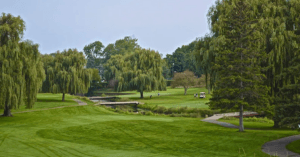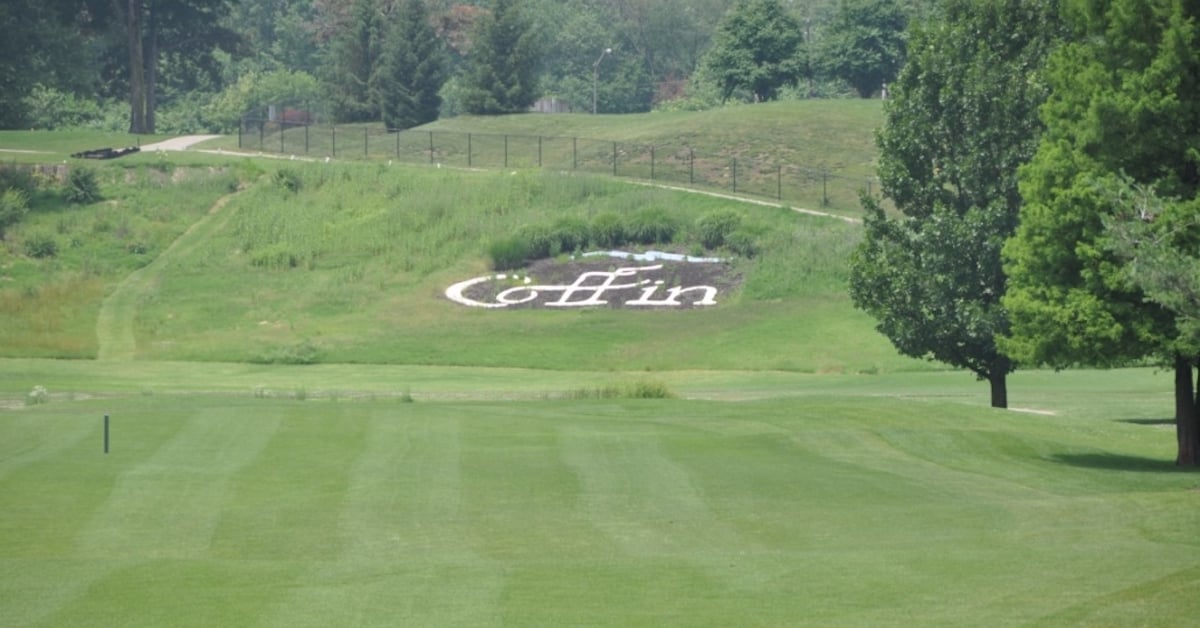
Many years ago a cynical newspaper editor scolded a wet-behind-the-ears reporter, “Kid, never let a few facts stand in the way of a good story.” I was that rookie sportswriter. But despite what you often read on social media or hear in Washington, DC, the truth does matter. It might just take some digging to find it.
As scattered written reports, oral recollections and conjecture tells it, the third oldest Michigan golf course was hatched by Cora Henry, Newton Swift and Daniel Quirk, Jr., in 1898. With some friendly persuasion and no doubt a little arm-twisting, they convinced a local farmer to let them “plant” three empty tomato cans in his freshly-cut hay field just west of Ypsilanti. They then invited a few of their drinking buddies over for a round of golf. The “event” was a big success, and a year later 15 men from the city and nearby Ann Arbor formed the Washtenaw Country Club. Individual dues were set at $5 and a ram’s head was adopted as the official insignia.
Automobiles hadn’t caught on yet and the easiest and most convenient way to reach the club was to hop on the Detroit Interurban street car which clamored along Packard Road between Ypsilanti and Ann Arbor. It didn’t take long for the game to grow in popularity as a favorite local pastime and, within a few years, more golfers carrying mashies, niblicks, cleeks and spoons (and a small arsenal of gutta percha balls) started showing up at the makeshift, three-hole track. The sheep kept on site to “mow” the fairways were replaced with more “modern” lawn equipment, the tin cans replaced with actual golf cups, and the small farm converted to a private club. Membership rapidly increased and Washtenaw expanded to six and later nine holes over the next decade.
The positioning of your tee ball and precision of your approach shot will ultimately determine how well you score at Washtenaw. It is, as one golf publication described it, deliciously old school.
In 1922 members voted to expand the golf course to 18 holes, convincing developers of an adjacent subdivision to donate the needed land as a way to increase the property value of their lots. In a stroke of good fortune, none other than Donald Ross — the most famous golf course designer in the world — happened to be visiting Ann Arbor at about the same time. He accepted an invitation to visit the club and after walking the grounds is reported to have said, “When God created this beautiful rolling land he must have intended it for a golf course.” Five years later Washtenaw hosted its first major golf tournament, the Michigan Amateur Championship. The event drew a record field with some of the participants sleeping outside on the club’s benches at night.
Like many of the earliest clubs built in the United States, Washtenaw experienced its share of tough economical times along the way — the Great Depression, two World Wars, recessions, an aging membership, competition from newer, upscale daily-fee facilities and the general ebb and flow of the unpredictable golf market all working against it. Yet, for more than a century, the course remained independently private attracting many of the movers-and-shakers of Washtenaw County and the surrounding areas to its hollowed links.
That all changed in 2009 when Washtenaw was sold to the private Polo Fields Golf Club in Ann Arbor. Ten years later, owner Stanley Berger sold Polo Fields but retained control of Washtenaw, opening it for public play. Then, in 2020, he sold it to a group headed by Michigan Golf Hall-of-Famer, Dave Kendall.
Not all narratives have a storybook ending. For example, over 800 courses in the United States have closed in the past decade. But sometimes fact can be stranger than fiction. And other times, the past and future can collide in such a way as to reignite a legend.
Kendall’s résumé is impeccable — two-time Michigan Senior Open Champion, Senior PGA Champion, Senior PGA Match Play Champion, Michigan PGA Teacher of the Year, and Michigan PGA Golf Professional of the Year to list just a few of his accomplishments. He’s one of the nicest, most sincere and positive guys you’ll ever meet, a character assessment his many students at the acclaimed Kendall Academy at Miles of Golf just a few blocks away from the club will attest. He also has a soft spot for the history and traditions of the game, and in particular Washtenaw Golf Club where he was a member from 2002-2008.
Since acquiring ownership three years ago, Kendall and his two business partners have followed through on a strategic long-range master plan to revitalize Washtenaw and give public golfers the opportunity to go back to the future. Teaming up with course architect Raymond Hearn, a veteran of pre-1900 golf course restoration/renovation, the course continues to make improvements today with the ultimate goal of bringing back the square-cornered greens, sight lines, fairway angles, and bunkering from its past while making the layout accessible, fun and fair for a new generation of players.
So what can the current crop of public golfers expect to find at Washtenaw? Not surprisingly, many of the same course features once reserved for private eyes only for more than a 100 years — a traditional style, classic design with narrow tree-lined fairways and well-guarded and quick undulating greens. While reasonably short by modern standards (par-72, with four sets of tees ranging from 4,744 to 6,564 yards) what the layout lacks in distance is made up for by a need for accuracy. The positioning of your tee ball and precision of your approach shot will ultimately determine how well you score. It is, as one golf publication described it, deliciously old school.
The layout’s parallel fairways take full advantage of natural land forms and the property’s surprisingly hilly terrain to create a variety of shot options. The 395-yard, par-4 No. 17 is an excellent example. The hole bends slightly to the left playing straight away until the 150-yard mark. It then dips down for 50 yards before making its ascent to a wide but narrow green angled away from the fairway. Sand guards the front left, back right and left corners.
The par-5, 511-yard No. 3 on the front side is also a favorite. A frozen rope off the tee is needed to avoid the fairway bunker on the left and trees on both sides. The second shot is uphill to a crest that hides the green from view. The approach is played to an open-faced green, allowing for a bit of creativity — a lob, pitch-and-run, or even a Texas wedge from the fairway is possible.
Water, too, must be navigated with small ponds and creeks dictating shot and club selection on eight holes, especially Nos. 7, 9, 16 and 18. All require forced carries on the approaches.
There are a few other notes about Washtenaw that deserve mention. First, the maintenance staff should be commended for maintaining private club standards even as the course has transitioned to public play. Second, you’d be hard-pressed to find a more accommodating and friendly staff. Third, the clubhouse, pro shop, dining facilities and banquet/wedding options are all top-notch. And lastly, given its pedigree, Washtenaw is exceedingly affordable. The course also participates in the TeeTime Golf Pass, making a round there even more of a bargain with our Upper Midwest Golf Pass.
Just about any article or story with roots that date back over 120 years is fair game for speculation and the occasional embellishment… just as fables and fairy tales are nearly always based on at least a kernel of truth. No one knows for sure who designed the original nine holes at Washtenaw. And it’s likely Donald Ross never actually put shovel to dirt on the second nine. Instead, it was completed by English golf pro and architect Herbert Way, who was indeed a good friend of Ross and assisted him with a handful of courses in the metro Detroit area. Washtenaw also briefly operated as a semi-private facility in the mid-1930s, when a “seasonal membership” was introduced to stave off closure. As for the tomato cans? I’m comfortable letting history be the judge.
COURSE LOCATION:
Washtenaw Golf Club
2955 Packard St, Ypsilanti, MI 48197






